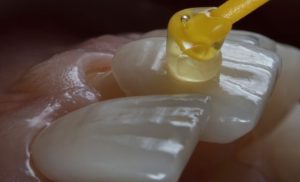Porcelain veneers and composite bonding are both popular cosmetic dental treatments that aim to improve the appearance of the teeth.
However, there are some key differences between the two:
-
Materials:
Porcelain veneers are made of a thin layer of porcelain that is custom-made to fit over the front surface of the tooth. It can be hand-made or machine-made, depending on the case. The treatment usually requires 2 visits
Composite bonding involves the application of a tooth-coloured resin material to the tooth surface. The material used in bonding can be matched to the natural colour of the teeth. The treatment usually only requires one visit. The result is highly dependable on the dentist’s skills, to make the restoration virtually undetectable.
-
Durability:
Porcelain is a strong material that can withstand daily wear and tear, making veneers a long-lasting solution. Porcelain veneers are generally more durable than composite bonding and can last up to 10-15 years or longer with proper care. Porcelain is resistant to stains, which means that the veneers will maintain their whiteness over time. Porcelain veneers are generally considered to be more natural-looking and are often used to address more significant cosmetic concerns, such as severely discoloured, misshapen, chipped or misaligned teeth, and to close larger gaps between teeth.
Composite bonding is not as durable as other cosmetic dental treatments such as crowns or veneers. The bonding material can chip or stain over time, and it may need to be replaced or repaired after a few years. Composite bonding may not be suitable if a tooth is significantly damaged, it is typically used for minor cosmetic issues, such as small chips or small gaps between teeth.
-
Preparation:
The process of getting veneers involves removing a thin layer of enamel from the tooth surface, to create room for the veneer, which is irreversible. More tooth structure might need to be removed to correct severe misalignment and discolouration.
Unlike other cosmetic dental treatments such as crowns or veneers, composite bonding is a non-invasive, reversible procedure that usually does not require the removal of any tooth structure.
-
Cost:
Porcelain veneers are generally much more expensive than composite bonding due to the cost of the materials and the additional preparation required.
It is important to discuss your goals, concerns, and expectations with your dentist before undergoing any cosmetic dental treatment. A skilled cosmetic dentist should be able to determine if composite bonding, porcelain veneers or a combination of both is the right treatment for you.
Dr Patricia has extensive training and experience with both composite bonding and porcelain veneers. She has been working as a cosmetic dentist Sydney for 22 years and doesn’t agree with the trend of “one treatment fits all”.
She believes in personalised or individualised care, which takes into account factors such as previous dental history, lifestyle, and personal preferences when designing a customised treatment plan.







